How to Fix Ripped Jeans on the Inner Thigh: A Complete Guide
It’s a frustrating moment we’ve all faced: you pull on your favorite pair of jeans only to find that familiar, dreaded rip on the inner thigh. This high-friction area, often called a “crotch blowout,” is usually the first place a beloved pair of jeans gives up. But before you demote them to the donation pile, I’m here to tell you that this is an easy fix.
As someone who has spent years mending, altering, and breathing new life into denim, I can assure you that with a little time and the right technique, you can make your jeans stronger than ever. This guide will walk you through four simple, step-by-step methods to repair those inner thigh holes, whether you’re a sewing novice or a seasoned pro.
Key Takeaways
- The Main Cause: Inner thigh rips are primarily caused by friction and continuous wear and tear as your thighs rub together while walking.
- Quickest Fix (No-Sew): For a fast, beginner-friendly solution, use an iron-on denim patch. It’s perfect for small holes and requires no sewing skills.
- Durable Hand-Sewn Fix: For a long-lasting repair without a machine, sew a patch on the inside of the jeans. This method offers excellent strength and is nearly invisible from the outside.
- The Strongest Repair: Using a sewing machine to darn over the worn area or secure a patch provides the most durable, professional-grade fix for large rips.
- Prevention is Key: You can prevent future rips by reinforcing the inner thigh area of new jeans with an internal iron-on patch before they start to wear thin.
Why Do Jeans Rip on the Inner Thigh?
Understanding why your jeans rip here is the first step to a lasting repair. The culprit is simple: friction. Every time you walk, the denim on your inner thighs rubs together, slowly weakening the cotton fibers. Over time, this constant wear and tear causes the fabric to thin out and eventually tear.
Other factors can speed up this process:
- Fabric Quality: Jeans with a high percentage of stretch material (like elastane) can wear out faster than 100% cotton denim.
- Fit: A tighter fit in the thigh area can increase tension and friction.
- Washing Habits: Washing your jeans too frequently can break down the fibers more quickly.
Before You Begin: Gathering Your Denim Repair Tools
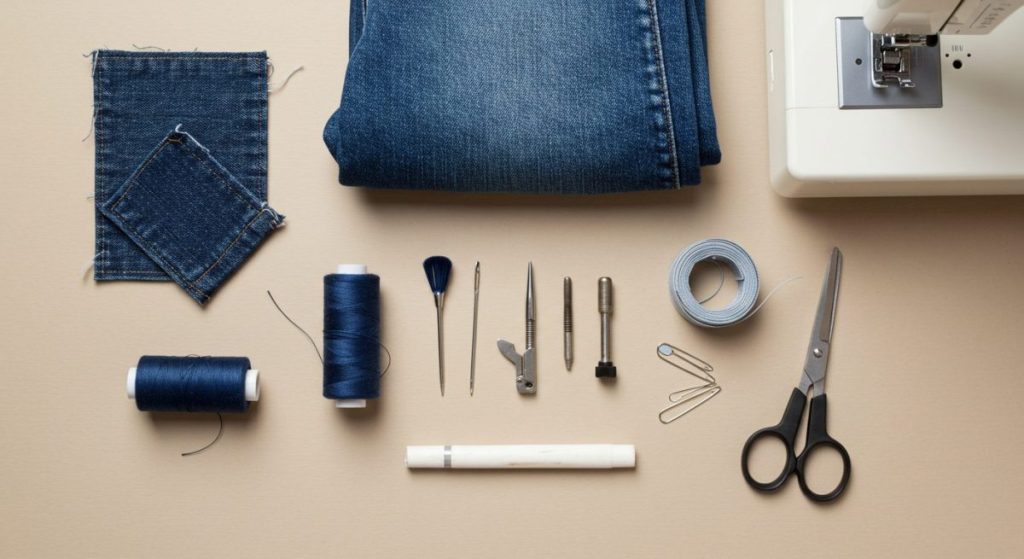
Having the right tools on hand makes the job much easier. First, trim any long, frayed threads around the hole with a pair of sharp scissors. Then, gather your supplies based on your chosen method.
For No-Sew Methods:
- Iron-on Denim Patches or Fusible Webbing
- An Iron
- Pressing Cloth (a piece of cotton fabric, like a pillowcase, works)
For Hand-Sewing:
- Denim Patch: Cut a piece from an old pair of jeans that you no longer wear.
- Needle: A darning needle or a sturdy, sharp needle works best.
- Thread: All-purpose or cotton thread that matches the color of your jeans.
- Sewing Pins
For Machine-Sewing:
- A Sewing Machine
- Denim Needles (Size 90/14 or 100/16 is ideal)
- Matching Thread
- A denim patch
Method 1: The Quick No-Sew Fix (Using Iron-On Patches)
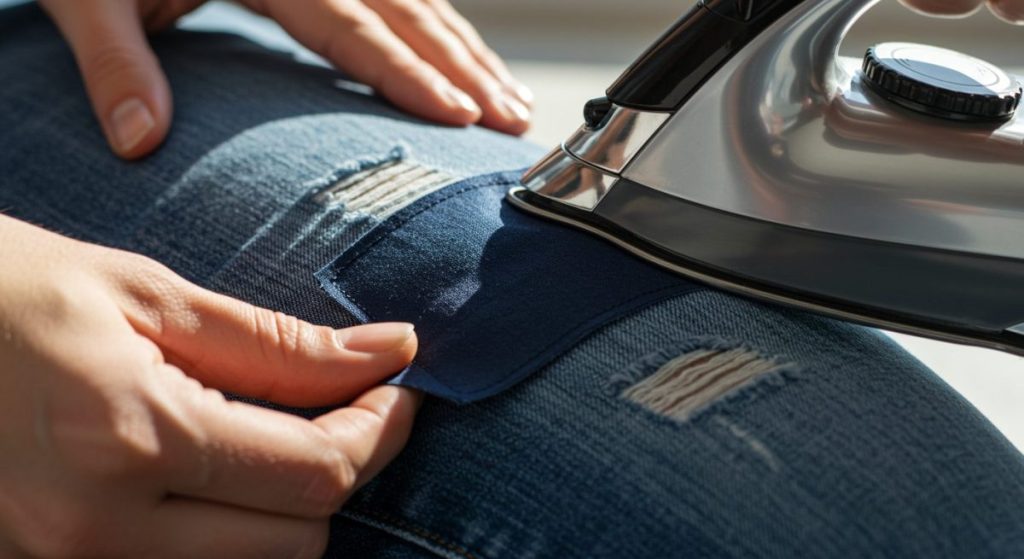
This is the fastest and easiest way to fix small holes or reinforce thinning areas. It’s a perfect solution if you don’t own a sewing machine or are new to mending.
- Prepare the Jeans: Turn your jeans inside out and lay the ripped area flat on an ironing board.
- Cut Your Patch: Cut the iron-on patch so it’s at least a half-inch (or 1.5 cm) larger than the hole on all sides. Rounding the corners helps prevent the patch from peeling up later.
- Position the Patch: Place the patch over the hole with the adhesive side facing down onto the denim.
- Iron it On: Set your iron to the heat setting recommended on the patch packaging (usually a high, no-steam setting). Place your pressing cloth over the patch and press down firmly with the hot iron for 30-45 seconds. Do not wiggle the iron around; just apply firm pressure.
- Let it cool: Allow the patch and jeans to cool completely before moving them. This ensures the adhesive sets properly.
Check out this quick video tutorial for a visual guide:
Method 2: How to Fix Ripped Jeans Inner Thigh by Hand
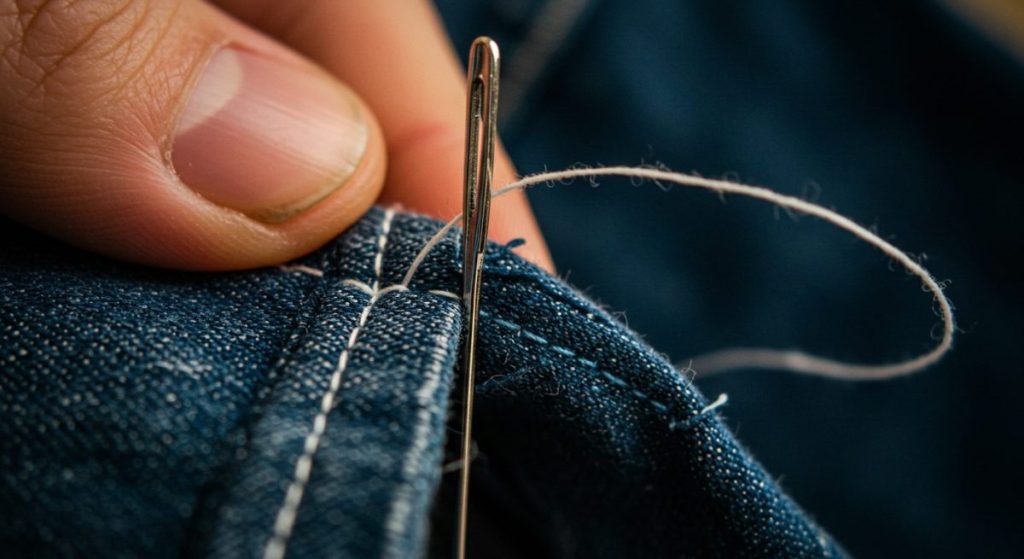
Hand-sewing a patch on the inside of your jeans is a fantastic, durable method that is nearly invisible from the outside. It takes a little more time but provides a flexible, long-lasting repair.
- Prepare Your Patch: Cut a piece of scrap denim slightly larger than the hole.
- Position the Patch: Turn your jeans inside out. Place the patch over the hole and secure it in place with sewing pins.
- Thread Your Needle: Thread your darning needle and tie a knot at the end of the thread.
- Start Sewing: Begin sewing from the inside of the jeans. Use a simple whipstitch or running stitch to secure the patch to the jeans. Keep your stitches small and close together, sewing all the way around the edge of the patch.
- Reinforce the Hole: After securing the patch, sew back and forth across the ripped area itself, catching the patch underneath. This darning motion further strengthens the weakened fabric.
- Knot and Trim: Once secure, tie off your thread with a knot and trim any excess.
For a great visual on hand-sewing techniques, see this video:
Method 3: Using a Sewing Machine for the Strongest Repair
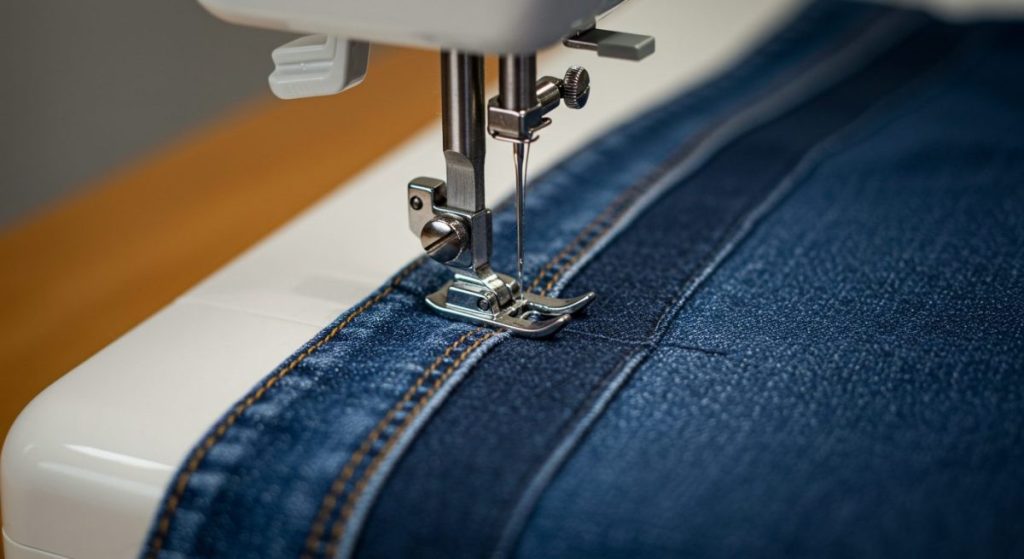
For the most durable, professional-grade fix, a sewing machine is your best friend. This method is ideal for larger rips or for areas that experience a lot of stress.
- Prepare the Jeans and Patch: Turn the jeans inside out. Cut a denim patch that generously covers the worn-out area and pin it in place.
- Set Up Your Machine: Install a denim needle (this is critical—it will prevent broken needles!). Thread your machine with a color that matches your jeans.
- Start Sewing: Place the thigh area under the needle. You may need to roll up the jean leg to maneuver it. Select a straight stitch or a narrow zig-zag stitch.
- Secure the Patch: Begin by sewing around the perimeter of the patch to lock it in place.
- Darn the Area: Sew back and forth across the entire patch area using the machine’s forward and reverse functions. Go in one direction (e.g., vertically), then switch and go in the other direction (horizontally). This cross-hatching motion builds a new, super-strong layer of thread and denim.
- Finish Up: Once the entire area is covered and feels strong, backstitch to lock your stitches, then trim the threads.
This video demonstrates the machine darning technique perfectly:
How to Prevent Inner Thigh Holes in Jeans
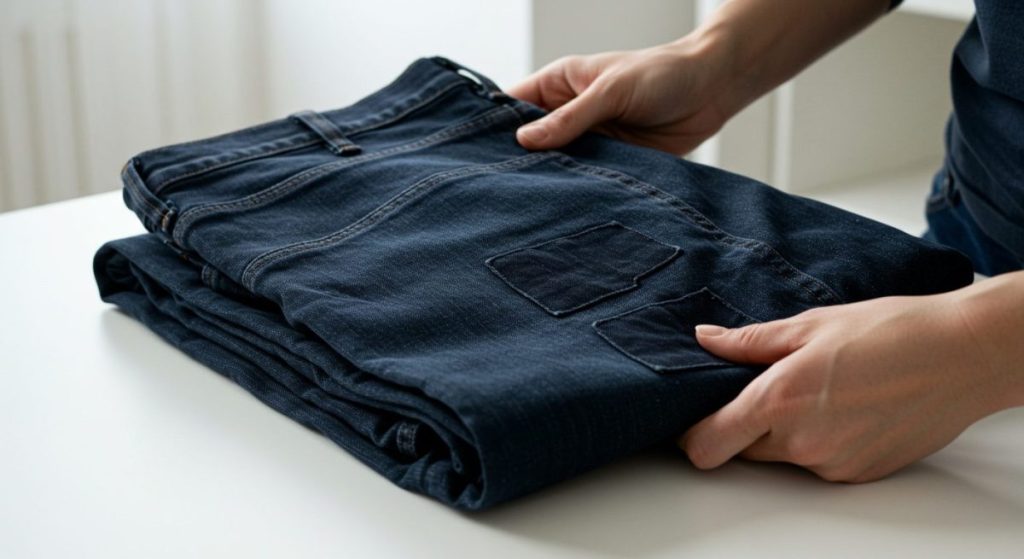
The best fix is prevention. To make your jeans last longer, follow these tips:
- Reinforce New Jeans: As soon as you buy a new pair of jeans you love, iron a fusible patch on the inside of the inner thigh area. This invisible layer of reinforcement will dramatically slow down wear and tear.
- Choose Durable Denim: Look for jeans made from heavier-weight, 100% cotton denim when possible, as they tend to be more durable than very stretchy blends.
- Wash Less, Wash Gently: Only wash your jeans when they are visibly dirty. When you do, turn them inside out, wash them in cold water on a gentle cycle, and hang them to dry instead of using a high-heat dryer.
Frequently Asked Questions
How do you fix ripped jeans on the inner thigh without sewing?
The best no-sew method is using an iron-on denim patch. Simply cut the patch to size, place it over the hole on the inside of the jeans, and press it firmly with a hot iron.
How do you patch ripped jeans from the inside?
Cut a piece of scrap denim larger than the hole. Turn the jeans inside out, pin the patch over the hole, and then use either a hand-sewing needle or a sewing machine to stitch around the edges of the patch and back and forth over the hole itself.
Why do my jeans always rip between the thighs?
This happens because of friction. The fabric in that area is constantly rubbing together when you walk, causing the fibers to weaken and eventually tear.
Conclusion
Saving your favorite pair of jeans from a premature end is not only sustainable but also incredibly rewarding. A rip in the inner thigh is a common issue, not a clothing crisis. By choosing the right method for your skill level—whether it’s a quick iron-on patch or a sturdy machine repair—you can easily extend the life of your denim. So grab your tools, and give those trusted jeans the second chance they deserve.






